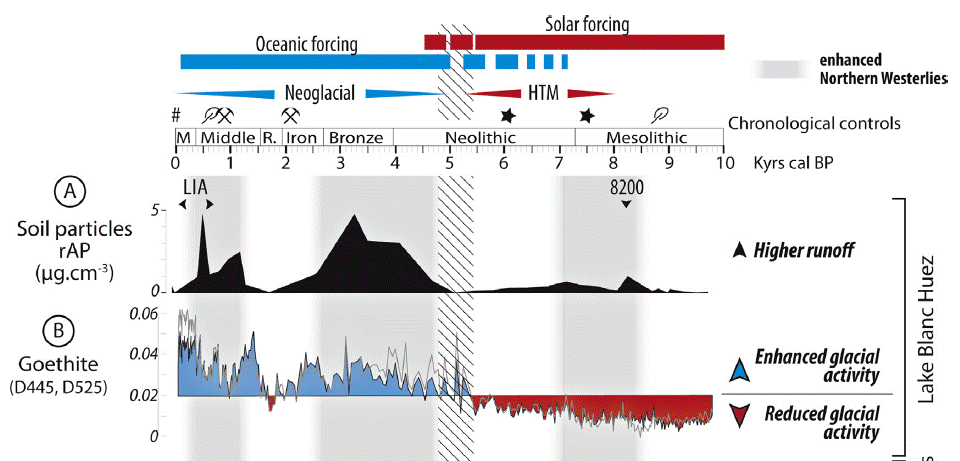Unser Gletscher-Faktencheck führt uns heute zunächst in die nördlichen Anden in Venezuela. Eine Forschergruppe um Nathan Stansell von der Northern Illinois University untersuchte die Gletschergeschichte der Region für die vergangenen 12.000 Jahre. Interessanterweise war die Entwicklung alles andere als monton. Während des sogenannten mittelholozänen Klimaoptimums waren weite Teil der venezuelanischen Anden gletscherfrei. Immer wieder gab es natürliche Schwankungen, die die Gletscher mal anschwellen und mal schrumpfen ließen. Während der Kleinen Eiszeit wuchsen die Gletscher signifikant an, gefolgt von der aktuellen Schmelzphase. Die Arbeit erschien im April 2014 in den Quaternary Science Reviews. Im Folgenden die Kurzfassung der Arbeit (relevante Passagen fett markiert):
Lake sediment records from the Cordillera de Mérida in the northern Venezuelan Andes document the history of local glacial variability and climate changes during the Holocene (∼12 ka to the present). The valleys that contain these lakes have similar bedrock compositions and hypsometries, but have different headwall elevations and aspects, which makes them useful for investigating the magnitude of past glaciations. There was widespread glacial retreat in the Venezuelan Andes during the early Holocene, after which most watersheds remained ice free, and thus far only valleys with headwalls higher than ∼4400 m asl contain evidence of glaciation during the last ∼10 ka. There was a pronounced shift in sediment composition for the Montos (headwall: ∼4750 m asl) and Los Anteojos (headwall: ∼4400 m asl) records during the middle Holocene from ∼8.0 to 7.7 ka when conditions appear to have become ice free and drier. There is tentative evidence that the glacier in the Mucubají valley (headwall: ∼4609 m asl) advanced from ∼8.1 to 6.6 ka and then retreated during the latter stages of the middle Holocene. Clastic sediment accumulation in other nearby lake basins was either low or decreased throughout most of the middle Holocene as watersheds stabilized under warmer and/or drier conditions. In the Montos record, there was another major shift in sediment composition that occurred from ∼6.5 to 5.7 ka, similar to other regional records that suggest conditions were drier during this period. Overall, the late Holocene was a period of warmer and wetter conditions with ice extent at a minimum in the northern tropical Andes. There were also punctuated decadal to multi-centennial periods of higher clastic sediment accumulation during the last ∼4 ka, likely in response to periods of cooling and/or local precipitation changes. In watersheds with headwalls above 4600 m asl, there is evidence of glacial advances during the Little Ice Age (∼0.6–0.1 ka). The pattern of glacial variability is generally similar in both the northern and southern tropics during the Little Ice Age, suggesting that ice margins in both regions were responding to colder and wetter conditions during the latest Holocene. The observed pattern of Holocene climate variability in the Venezuelan Andes cannot be explained by insolation forcing alone, and tropical ocean influences were likely associated with the observed glacial and lake level changes.
Auch in den Anden Patagoniens gestaltete sich die vorindustrielle Gletscherentwicklung äußerst wechselhaft, wie ein Forscherteam um Jorge Strelin vom Instituto Antártico Argentino der Universidad Nacional de Córdoba im Oktober 2014 in den Quaternary Science Reviews dokumentieren konnte. Gletscherwachstumsphasen ereigneten sich während der Kleinen Eiszeit, der Kälteperiode der Völkerwanderungszeit sowie der Kaltphase vor der Römischen Wärmeperiode. In den dazwischenliegenden Wärmeperioden gab es entsprechende Schmelzphasen. Im Folgenden ein Auszug aus der Kurzfassung:
We present new geomorphic, stratigraphic, and chronologic data for Holocene glacier fluctuations in the Lago Argentino basin on the eastern side of the southern Patagonian Andes. Chronologic control is based on 14C and surface-exposure 10Be dating. After the Lateglacial maximum at 13,000 cal yrs BP, the large ice lobes that filled the eastern reaches of Lago Argentino retreated and separated into individual outlet glaciers; this recession was interrupted only by a stillstand or minor readvance at 12,200 cal yrs BP. The eight largest of these individual outlet glaciers are, from north to south: Upsala, Agassiz, Onelli, Spegazzini, Mayo, Ameghino, Perito Moreno, and Grande (formerly Frías). Holocene recession of Upsala Glacier exposed Brazo Cristina more than 10,115 ± 100 cal yrs BP, and reached inboard of the Holocene moraines in Agassiz Este Valley by 9205 ± 85 cal yrs BP; ice remained in an inboard position until 7730 ± 50 cal yrs BP. Several subsequent glacier readvances are well documented for the Upsala and Frías glaciers. The Upsala Glacier readvanced at least seven times, the first being a relatively minor expansion – documented only in stratigraphic sections – between 7730 ± 50 and 7210 ± 45 cal yrs BP. The most extensive Holocene advances of Upsala Glacier resulted in the deposition of the Pearson 1 moraines and related landforms, which are divided into three systems. The Pearson 1a advance occurred about 6000–5000 cal yrs BP and was followed by the slightly less-extensive Pearson 1b and 1c advances dated to 2500–2000 and 1500–1100 cal yrs BP, respectively. Subsequent advances of Upsala Glacier resulted in deposition of the Pearson 2 moraines and corresponding landforms, also separated into three systems, Pearson 2a, 2b, and 2c, constructed respectively at ∼700, >400, and <300 cal yrs BP to the early 20th century. Similar advances are also recorded by moraine systems in front of Grande Glacier and herein separated into the Frías 1 and Frías 2a, 2b, and 2c.
Eine weitere Studie über die Region stammt von einem Forscherteam um Julie Elbert vom Oeschger-Zentrum für Klimaforschung der Universität Bern. Die Wissenschaftler rekonstruierten mithilfe von saisonal geschichteten Seensedimenten die Klimageschichte der letzten 1500 Jahre im chilenischen Nord-Patagonien. Dabei fanden sie die Kälteperiode der Völkerwanderungszeit sowie die Kleine Eiszeit, Interessanterweise ereignete sich die wärmste Phase des Untersuchungszeitraums nicht etwa in der Heutezeit, sondern während des 19. Jahrhunderts (Abbildung 1). Hier die entsprechende Passage aus der Kurzfassung der Arbeit, die im April 2013 als Diskussionsformat in Climate of the Past erschien:


